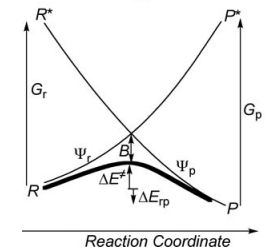VBTutorial3
State correlation diagrams
Exercise 1 : Computation of state correlation Diagrams for a 3 centers / 4 electrons system
In this exercise the <math>\textrm{S}_{\textrm{N}}2</math> reaction Cl<math>{}^{-}</math> + CH3Cl -> ClCH3 + Cl<math>{}^{-}</math> will be studied in both vacuum and solution. Valence Bond State Correlation Diagrams will be constructed at <math>\pi</math>-D-BOVB level. There are two parts in this exercise: basis part and optional part. The basis part is performed with MCP-DZP basis set in which the inner orbitals in Cl and C are described with MCP pseudo potential. The optional part is performed with 6-31+G* basis set, which is the part for experienced users. Only reactant and transition state will be computed in this exercise.
Note:How to perform a VBPCM calculation
A VBPCM calculation is performed in the similar way as the VB calculations in vacuum. One should prepare a GAMESS input file with solvent assigned such as:
The details of PCM calculation in the GAMESS can be found in GAMESS manual. Keyword "VBTYP=XMVB" in CONTRL section is also essential. After the GAMESS input file is prepared, an XMI file with keyword "VBPCM" should be prepared with the same file name as GAMESS input file. In the current XMVB package, VBSCF/PCM and BOVB/PCM calculations are both supported.
Compute the Energies and Wavefunctions at Reactant and Transition State with Different Sets of VB Structures
- Write the following VB structure sets for a 3 centers / 4 electrons system :
- all structures;
- minimal structures for reactant;
- minimal structures for product.
- Perform <math>\pi</math>-D-BOVB calculation for reactant (see "high symmetry cases" here):
- Perform all-structure <math>\pi</math>-D-BOVB calculation as following:
- Perform L-VBSCF calculation with "orbtyp=hao frgtyp=sao guess=mo", in which the orbitals are all localized on the Cl and CH<math>{}_3</math> groups;
- Perform D-VBSCF calculation where <math>\pi</math> oribtals are delocalized in the whole system and the <math>\sigma</math> orbitals are kept localized. Use the L-VBSCF orbitals as initial guess;
- Perform D-BOVB calculation with D-VBSCF orbital as initial guess.
- Perform <math>\pi</math>-D-BOVB calculations with minimal structures for reactant and product with the same procedure as all-structure calculation.
- Perform all-structure <math>\pi</math>-D-BOVB calculation as following:
- Perform <math>\pi</math>-D-BOVB calculation for transition state. The procedure is the same as step 2.
- Perform <math>\pi</math>-D-BOVB/PCM calculations for reactant:
- Perform all-structure <math>\pi</math>-D-BOVB/PCM calculation for the reactant in following steps:
- Perform L-VBSCF/PCM calculation with L-VBSCF orbitals as initial guess;
- Perform D-VBSCF/PCM calculation with L-VBSCF/PCM orbitals as initial guess;
- Perform D-BOVB/PCM calculation with D-VBSCF/PCM orbitals as initial guess.
- Perform <math>\pi</math>-D-BOVB/PCM calculations with minimal structures for reactant and product in the sames steps as all structure calculation.
- Perform all-structure <math>\pi</math>-D-BOVB/PCM calculation for the reactant in following steps:
- Perform BOVB/PCM calculations for transition state with the same procedure as step 4.
Analysis: Wavefunctions and Energies
- Compare the weights of structures at both reactant and transition state points, find the differences.
- Compute the Barrier height of the <math>\textrm{S}_{\textrm{N}}2</math> reaction in both vacuum and solution. See the difference of the barrier heights, and find out the reason.
- Compare the energies of reactant and product structures at reactant and transition state geometries, in both vacuum and solution. What's the difference of the energies at different points? Why?
- Compute the resonance energies at both reactant and transition state points, see the difference of the resonance energies.
In this part, calculations with BFI section are performed with 6-31+G* basis set, which is desired for the experienced users. The inner orbitals are frozen as HF orbitals in all VB calculations and the valence basis functions are reorganized to hybrid basis functions so that the <math>\sigma</math>, <math>\pi_x</math> and <math>\pi_y</math> spaces can be separated well. A D-BOVB calculation is performed in 2 steps:
- Perform a VBSCF calculation with <math>\pi</math> orbitals delocalized in the whole system and <math>\sigma</math> orbitals localized on the Cl and CH<math>{}_3</math> groups;
- Perform a BOVB calculation with VBSCF orbitals as initial guess.
The VB calculations are the same as the calculations performed above. Try to understand the BFI section, perform the calculations and compare the differences of barrier heights, resonance energies and performances with and without $BFI.
>> general guidelines for BOVB calculations
